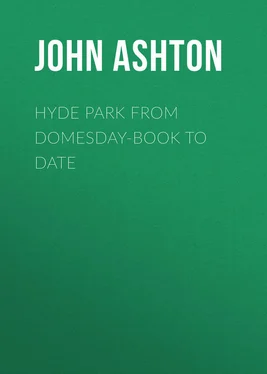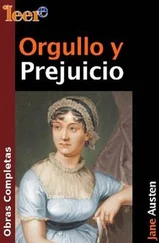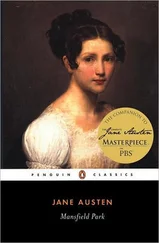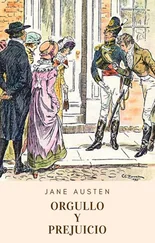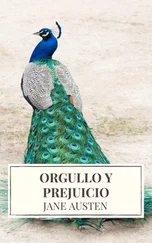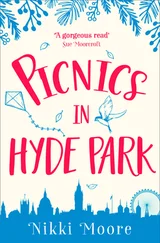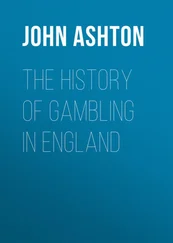John Ashton - Hyde Park from Domesday-book to Date
Здесь есть возможность читать онлайн «John Ashton - Hyde Park from Domesday-book to Date» — ознакомительный отрывок электронной книги совершенно бесплатно, а после прочтения отрывка купить полную версию. В некоторых случаях можно слушать аудио, скачать через торрент в формате fb2 и присутствует краткое содержание. Жанр: foreign_antique, foreign_prose, на английском языке. Описание произведения, (предисловие) а так же отзывы посетителей доступны на портале библиотеки ЛибКат.
- Название:Hyde Park from Domesday-book to Date
- Автор:
- Жанр:
- Год:неизвестен
- ISBN:нет данных
- Рейтинг книги:3 / 5. Голосов: 1
-
Избранное:Добавить в избранное
- Отзывы:
-
Ваша оценка:
- 60
- 1
- 2
- 3
- 4
- 5
Hyde Park from Domesday-book to Date: краткое содержание, описание и аннотация
Предлагаем к чтению аннотацию, описание, краткое содержание или предисловие (зависит от того, что написал сам автор книги «Hyde Park from Domesday-book to Date»). Если вы не нашли необходимую информацию о книге — напишите в комментариях, мы постараемся отыскать её.
Hyde Park from Domesday-book to Date — читать онлайн ознакомительный отрывок
Ниже представлен текст книги, разбитый по страницам. Система сохранения места последней прочитанной страницы, позволяет с удобством читать онлайн бесплатно книгу «Hyde Park from Domesday-book to Date», без необходимости каждый раз заново искать на чём Вы остановились. Поставьте закладку, и сможете в любой момент перейти на страницу, на которой закончили чтение.
Интервал:
Закладка:
John Ashton
Hyde Park from Domesday-book to Date
PREFACE
The only History of Hyde Park, at all worthy of the name, is Vol. I. of “The Story of the London Parks,” by Jacob Larwood. But, its author says, definitely, “What happened in Hyde Park subsequently to 1825, approaches too near to contemporary history to be told in these pages.” This (for Hyde Park has a history since then), added to the inaccuracies and imperfections of the book, has induced me to write a History of Hyde Park from Domesday Book to Date.
JOHN ASHTON.CHAPTER I
The forests round London – The manor of Eia in Domesday Book – Its subdivision – The Manor of Hyde – The Manor of Ebury – The Manor of Neate – The Neat houses – Henry VIII. and Hyde Park – Queen Elizabeth and Hyde Park – James I. – The deer in the park – Last shooting therein – Foxes – The badger.
In old times London was surrounded by forests, of which the only traces now remaining are at Bishop’s Wood, between Hampstead and Highgate, and the Chase at Enfield. FitzStephen, who lived in the reign of Henry II., tells us, in his Description of London, that beyond the fields to the north of London was an immense forest, beautified with woods and groves – or in other words, park land – full of the lairs and coverts of beasts and game, stags, bucks, boars and wild bulls. Contrary to what one might expect, these forests were not reserved for the sole hunting of the King and his favourites; but, as we are informed by the same writer, many of the citizens took great delight in fowling, with merlins, hawks, etc. (which showed how wealthy they were at that time), and they had the right and privilege of hunting in Middlesex, Hertfordshire, in all the Chiltern country, and in Kent, as far as the River Cray. And this forest of Middlesex was only disforested in 1218 (2 Henry III.).
If, however, Hyde Park was, primævally, a forest, it must have been cleared and brought into cultivation in the Saxon times, for there is no mention of a forest, or even woodland, in the Domesday Book account of the Manor of Eia – in which Hyde Park was situate: on the contrary, it seems as if it was highly cultivated, as is evidenced by the following translation of that portion of the book relating to this manor: —
“Ossulton Hundred. The land of Geoffrey Mannevile. 1 1 Ancestor of the family of Mandeville, Earls of Essex.
Geoffrey de Mannevile holds the Manor of Eia. It was assessed for 10 hides 2 2 A hide was 100 or 120 acres – as much land as one plough could cultivate in a year.
/. The land is 8 carucates/ 3 3 A Carucate was as much arable land as could be cultivated by one plough in a year, with sufficient meadow and pasture for the team.
. In demesne 5 hides, and there are 2 ploughs/ 4 4 A plough is the same as a Carucate.
. The villans 5 5 These were not slaves, but persons used and employed in the most servile work, and belonging, both they and their children, and their effects, to the lord of the soil, like the rest of the cattle or stock upon it.
have 5 ploughs, and a 6th might be made. There is 1 villan with half a hide/ and 4 villans each with 1 virgate, 6 6 A Virgate was from 8 to 16 acres of land.
and other 14 each with half a virgate/ and 4 bordars 7 7 Bordars were peasants holding a little house, bigger than a cottage, together with some land of husbandry.
with one virgate, and 1 cottager. Meadow for 8 ploughs’ teams, and of hay/ 60 s. of pasture 7 s. In all the profits it is worth £8/ when received £6. In the time of King Edward £12/. Harold, son of Earl Radulf, held this manor, whom Queen/ Editha had the custody of with this manor, on the day that King Edward was alive and dead./ Afterwards, William, the Chamberlain, held it of the Queen in fee for £3,/ yearly to farm. And after the death of the Queen, he now holds it/ of the King, in the same manner. It is now 4 years since William lost the manor, and nothing has been received from the King’s farm, that is £12.”
This Manor of Eia was bounded on the north by the Via Trinobantina , a road which crossed England from the coast of Suffolk to that of Hampshire, and we now call that portion by Hyde Park the Uxbridge Road: and on the east ran the Watling Street , a road from Chester to Dover (of which the Edgware Road is a portion), which crossed the Via Trinobantina , and continued down Park Lane to the Thames – which was the southern boundary of the manor.
About the compilation of Domesday Book the Manor of Eia (we know not why) was divided into three manors, named severally Hyde, Ebury (or Eubery), and Neate (or Neyt), and was given by Geoffrey de Manneville to the Monastery of St. Peter in Westminster, where his wife Athelais was interred, and it was in the possession of this monastery till 1536. The Manor of Neate was nearest the river, about Chelsea, and there it was that the abbots of Westminster had a pleasure house. We read 8 8 An History of the Church of St. Peter, Westminster, by R. Widmore, 1751.
how Nicholas Littlington, who was prior of the Monastery, was made Abbot on the elevation of Abbot Simon Langham to the See of Ely in 1362, and how “he improved the estate of the convent at Hyde” – and also how he died, November 29th, 1386, “at the Manor house of Neyte near Westminster, at that time thought a good building; for the Duke of Lancaster, 9 9 John of Gaunt, brother of Edward III., and titular King of Castile.
styling himself King of Castile, desired leave of the Abbot to reside there during a sitting of parliament at Westminster.” And here also was born John, the fifth son of Richard, Duke of York, on November 7th, 1448. Here died (May 12th, 1532) John Islip, who was elected Abbot of Westminster October 27th, 1500, and was buried in a chapel in the Abbey, which he built and which is still called by his name. In his abbacy (1502-3) the building of Henry VII.’s Chapel was begun, and in 1532 he negotiated an exchange between the Abbey and the King; the latter had from the Abbey about one hundred acres of land, part of which was made into St. James’s Park, and the former received in exchange the priory of Poughley, in Berks, of which Cardinal Wolsey had procured the dissolution, to help him endow the colleges he designed at Oxford and Ipswich.
Islip’s successor was William Boston, and, in 1536, an Act of Parliament was passed (28 Henry VIII., c. 49) and confirmed by a conveyance dated July 1, 1537, granting the King the lands belonging to the Abbey of “Nete, within the towne and paryshes of Westmynster and Seynt Martyn’s in the Felde,” as also the manors of Neyte, Ebery, and Todington, of the advowson of Chelsea rectory, of some lands at Greenwich, and of several meadows and closes near the Horseferry: in return for which the Abbey was to receive the site of the newly dissolved Priory of Hurley, in Berkshire; which, somewhat singularly, formerly belonged to the same Geoffrey de Manneville who gave the Abbey the Manor of Eia.
The Manor of Ebury lay between the other two manors, and comprised the district now known as Belgravia and Pimlico. It never was historically famous, but it helped to swell the coffers of the Grosvenors, especially that of the present Duke of Westminster and his father, for the manor (of 430 acres) then called Eabury or Ebury Farm came into the possession, in 1656, of Sir Thomas Grosvenor, who married the daughter and sole heiress of Alexander Davies, Esq., of Ebury Farm, who never could have contemplated the princely fortune he was leaving to her descendants.
Once only do we hear anything particular of the Manor of Ebury, and that is in connection with Queen Elizabeth. 10 10 Strype’s edit, of Stow’s Survey, ed. 1720. Book VI. p. 80.
“That Ebery Farm , containing 430 Acres, Meadow and Pasture, which was holden of her Majesty by lease, was granted to one Whashe , who paid £21 per Ann. And the same was let to divers Persons, who, for their private Commodity, did enclose the same, and had made Pastures of Errable Land; thereby not only annoying her Majesty in her Walks and Passages, but to the hindrance to her Game, and great Injury to the Common, which, at Lammas , was wont to be laid open, for the most Part; as by ancient Precedents thereof made, do particularly appear, both in the Time of Henry the Eighth , Edward the Sixth , and Queen Mary . And by the Grant made from her Majesty to the new tenants, it appeareth, that they are to enjoy the same lands in such sort as their predecessors did, which was then always Lammas ground, and now enclosed about 20 years past.”
Интервал:
Закладка:
Похожие книги на «Hyde Park from Domesday-book to Date»
Представляем Вашему вниманию похожие книги на «Hyde Park from Domesday-book to Date» списком для выбора. Мы отобрали схожую по названию и смыслу литературу в надежде предоставить читателям больше вариантов отыскать новые, интересные, ещё непрочитанные произведения.
Обсуждение, отзывы о книге «Hyde Park from Domesday-book to Date» и просто собственные мнения читателей. Оставьте ваши комментарии, напишите, что Вы думаете о произведении, его смысле или главных героях. Укажите что конкретно понравилось, а что нет, и почему Вы так считаете.
